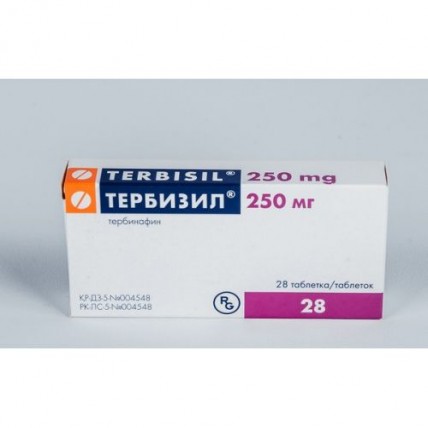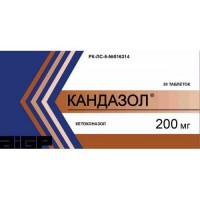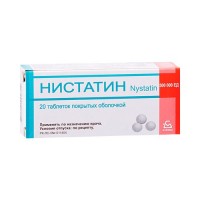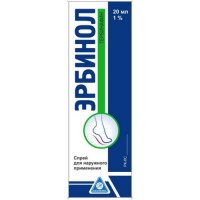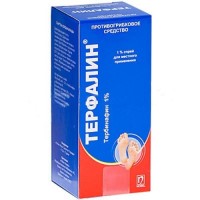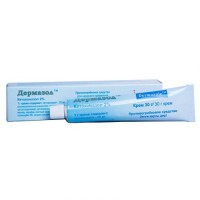Terbizil 250 mg (28 tablets)
- $102.70
Out Of Stock
The instruction for medical use of TERBIZIL® medicine the Trade name of Terbizil® the International unlicensed name Terbinafin Lekarstvennaya a form of the Tablet, 250 mg Structure One tablet contains active agent - terbinafin 250 mg (in the form of a terbinafin of a hydrochloride of 281.25 mg) excipients: silicon dioxide colloidal, anhydrous, magnesium stearate, a gipromelloza, cellulose microcrystalline, sodium glikolit starch (type A). The description of the Tablet of round shape, with a biconvex surface, white or almost white color, with risky on one party and with an engraving 250 on other party Pharmacotherapeutic group Antifungal drugs for treatment of diseases of skin. Antifungal drugs for system use. Terbinafin the ATX D01BA02 Code the Pharmacological Pharmacokinetics Later properties of single dose of a terbinafin inside in a dose of 250 mg its maximum concentration in plasma (Cmax) is reached in 1.5 hours and makes 1.3 mkg/ml. After oral administration the absorption of a terbinafin is also gt, 70%. Absolute bioavailability of a terbinafin as a result of presistemny metabolism about 50%. At constant reception of a terbinafin its maximum concentration increased on average by 25% more, in comparison with single dose, the area under a pharmacokinetic curve of concentration of active agent in blood plasma increased by 2.3 times. Terbinafin's distribution strongly contacts proteins of blood plasma (99%). It quickly gets through a thermal layer of skin and collects in a lipophilic corneal layer. Gets into secretion of sebaceous glands that leads to creation of high concentrations in hair follicles, hair and oily skin. Terbinafin collects in nail plates within the first several weeks after an initiation of treatment. Biotranformation Terbinafin is metabolized quickly and in essential degree with the participation of at least seven isoenzymes of P450 cytochrome, at the same time the main role is played by isoenzymes of CYP2C9, CYP1A2, CYP3A4, CYP2C8 and CYP2C19. As a result of biotransformation of a terbinafin the metabolites which do not have antifungal activity are formed. Removal Metabolites are removed mainly with urine. The elimination half-life calculated on the basis of increase in AUC plasma makes about 30 hours. The research of blood samples after reception of repeated doses showed that the curve of elimination has three-phase character, final elimination half-life makes about 16.5 days. Bioavailability Because of presistemny metabolism the absolute bioavailability of a terbinafin is about 50%. Special categories of patients of Clinically significant changes of pharmacokinetics connected with age patients it is not revealed. In pharmacokinetic researches of a single dose of a terbinafin at patients with the accompanying renal failures (clearance of creatinine & lt, 50 ml/min.) and with diseases of a liver the possibility of decrease in clearance of drug for 50% was shown, therefore dose adjustment is required. The pharmacodynamics of Terbizil® is the allylamine having a wide range of antifungal action. Тербизил® it is used for the treatment of fungal infections of skin and nails caused by the following fungi: Trichophyton (for example, T. rubrum, T.mentagrophytes, T. verrucosum, T. violaceum), Microsporum (for example, M. canis) and Epidermophyton floccosum, Candida (C. albicans) and Pityrosporium from group of yeast-like mushrooms (for example, Candida albicans). In small concentration drug has fungicide effect concerning dermatophytes, yeast-like mushrooms and some dimorphous mushrooms. The activity concerning barmy mushrooms, for example, of the sort Candida, can be fungicidal or fungistatic, depending on their look. Тербизил® suppresses an early stage of biosynthesis of sterols in a mushroom cell at the expense of skvalenepoksidaza enzyme inhibition in a cellular membrane of a mushroom that leads to intracellular accumulation of squalene and causes death of a cell of a mushroom. At oral administration, drug collects in skin, nails and hair, in the concentration providing fungicide action. Indications - mycoses of a hairy part of the head - the onychomycoses caused by dermatophytes (the fungal infections affecting a nail plate) - the fungal infections of skin, nail plates and a hairy part of the head caused by Trichophyton fungi, for example, of T. rubrum, T. mentagrophytes, T. verrucosum, T. violaceum, Microsporum canis and Epidermophyton floccosum - system treatment of widespread mycosis of smooth skin of a trunk, feet and inguinal area - the skin infections caused by mushrooms of the sort Candida Note: unlike topical treatment by Terbizil® cream, the tablets Terbizil® are not effective at treatment scaly (multi-colored) depriving, Pityrosporum orbiculare caused by a mushroom (as known as Malessezia furfur). The route of administration and doses Duration of therapy is defined by character and disease severity. Adults On 250 mg (1 tablet) of 1 times a day. The onychomycosis In an onychomycosis of hands the treatment period usually makes 6 weeks. In an onychomycosis of feet, especially a thumb, duration of treatment has to be 12 weeks. In certain cases with a slow growth of a nail the course of treatment can be longer. The optimum clinical effect is observed in several months after mycologic treatment and the termination of therapy. It is defined by that span which is necessary for growth of a healthy nail. Mycoses of integuments the Recommended treatment duration in dermatomycoses of feet (interdigital, bottom or as mokasin) – from 2 to 6 weeks, in a dermatomycosis of smooth skin of a trunk, extremities – from 2 to 4 weeks. In skin candidiasis duration of treatment is from 2 to 4 weeks. The probable duration of treatment at defeats of a hairy part of the head (mycoses of a hairy part of the head) is 4 weeks. The absolute clinical recovery can be expected several weeks later after performing antifungal therapy. Additional information on special populations of patients Patients with an abnormal liver function is not recommended to appoint tablets of a terbinafin to patients with chronic or acute diseases of a liver. Patients with a renal failure the Use of tablets of a terbinafin for patients with a renal failure is studied insufficiently and therefore it is not recommended for treatment of this group of patients. Patients of advanced age there are no certificates that treatment of patients of advanced age (65 years are more senior) requires purpose of the doses different from the doses specified for younger patients or that they to a thicket have side effects from administration of drug. When assigning tablets of a terbinafin the patients of this age group need to consider the probability of existence at them of an abnormal liver function or kidneys the Route of administration of the Tablet swallow, without chewing, washing down with a small amount of water. It is desirable to take a pill every day at the same time. A pill can be taken on an empty stomach or after a meal. Side effects Very often (≥ 1/10) - the loss of appetite - headaches - disturbances from digestive tract (abdominal distension, a slight abdominal pain, dyspepsia, nausea), diarrhea - rash, urticaria - joint, muscles pain is frequent (³1/100 to & lt, 1/10) - fatigue - a hypogeusia, decrease, distortion and loss of flavoring feelings, dizziness - a depression owing to disturbance of flavoring feelings - a disorder of vision Infrequently (³1/1.000 to & lt, 1/100) - uneasiness owing to disturbance of flavoring feelings - sonitus - fever - paresthesia, a hypesthesia - anemia - reactions of photosensitivity, a photodermatosis, allergic reactions, photosensitivity, a polymorphic dieback - weight reduction owing to disturbance of flavoring feelings Is rare (³1/10.000 to & lt, 1/1000) - gepatobiliarny dysfunction (cholestasia), a liver failure, hepatitis, jaundice, increase in activity of proteolytic enzymes of a liver is Very rare (& lt, 1/10000) - an agranulocytosis, a neutropenia, thrombocytopenia, a pancytopenia - psoriazopodobny rashes, exacerbation of psoriasis - aggravation of a course of a skin and system lupus erythematosus - anaphylactoid reactions (including, a Quincke's disease), a demonstration or deterioration in a course of a skin and system lupus erythematosus - Stephens-Johnson's syndrome, a toxic epidermal necrolysis, a hair loss, sharp generalized ekzentematozny pustulez, a multiformny erythema, a toxidermia, exfoliative dermatitis, bullous dermatitis Frequency is unknown (it cannot be estimated on the basis of the available data) - anaphylactic reactions, reactions like a serum disease - an anosmia, including resistant, a hyposmia - illegibility of sight - decrease in visual acuity - a gipoakuziya (hearing disorder) - a vasculitis - pancreatitis - rash in combination with an eosinophilia and system symptoms - grippopodobny symptoms - a rhabdomyolysis - increase in activity of a kreatinfosfokinaza of the Contraindication - hypersensitivity to active ingredient or to any of excipients - children's age up to 18 years (in connection with limited data on safety of use in this age group) Medicinal interactions Influence of others of medicine on terbinafin the Plasma clearance of a terbinafin can accelerate medicines which induce P450 cytochrome and can be slowed down by medicines which inhibit this system of enzymes. When simultaneous use of the specified medicines is necessary, the corresponding dose adjustment of the drug Terbizil® can be required. Cimetidinum reduces clearance of a terbinafin by 33%. Rifampicin increases clearance of a terbinafin by 100%. Flukonazol – because of the inhibiting effect on CYP enzymes 2C9 and CYP 3A4 – increases Cmax and AUC of a terbinafin by 52% and 69%, respectively. Similar increase in concentration of a terbinafin can happen at a concomitant use with terbinafiny the drugs inhibiting CYP2C9 and CYP3A4 such as ketokonazol and Amiodaronum. Impact of a terbinafin on other Terbinafin medicines is characterized by the slight potential of suppression or strengthening of clearance of the majority of the drugs metaboliziruyemy by means of the system of P450 cytochrome (for example, a terfenadina, a triazolama, tolbutamide or oral contraceptives), except for drugs, metaboliziruyemy CYP2D6 (see below). Тербизил® does not affect clearance of antipyrine, digoxin. Тербизил® suppresses the metabolism mediated by CYP2D6 enzyme. Therefore the care is necessary during joint prescription of medicines which are mainly metabolized with participation of this enzyme (for example, tricyclic antidepressants, β-blockers, the selective serotonin reuptake inhibitors (SSRI), MAO inhibitors of B type and antiarrhytmic drugs of classes 1A, 1B and 1C). Тербизил® reduces clearance of the caffeine applied intravenously by 19% and clearance of desipramine for 82%. Тербизил® increases clearance of cyclosporine by 15%. Тербизил® does not affect clearance of antipyrine, digoxin. Terbinafin is a fast metabolizator of dextromethorphan (medicine against cough and substrate for CYP2D6). Thus, terbinafin can turn fast metabolizator of CYP2D6 into slow metabolizator. Terbinafin is characterized by the slight potential of suppression or strengthening of clearance of the majority of the drugs metaboliziruyemy by means of the system of P450 cytochrome (for example, a terfenadina, a triazolama, tolbutamide or oral contraceptives), except for drugs, metaboliziruyemy CYP2D6 (see above). Influence of a terbinafin on pharmacokinetics of a flukonazol is not revealed. Besides, clinically significant interaction between terbinafiny and such drugs as co-trimoxazole (Trimethoprimum/sulfamethoxazole), a zidovudine or theophylline is not revealed. At some patients accepting terbinafin along with oral contraceptives several cases of disturbance of a menstrual cycle are noted, however the frequency of these disturbances remained within the background frequency characteristic of the patients accepting only oral contraceptives. Terbizil® to patients with chronic or acute diseases of a liver is not recommended to appoint the special instructions Function of a Liver. Before purpose of a terbinafin inside it is necessary to conduct a research of function of a liver (hepatic tests). Manifestations of hepatotoxicity can develop as at patients with already available liver diseases, and without them therefore it is necessary periodically (each 4-6 weeks of treatment) to conduct a research of function of a liver. In case of increase in these indicators the treatment terbinafiny has to be immediately stopped. Patients to whom the oral Terbizil® drug treatment is prescribed have to be instructed about need to report immediately about any signs or symptoms such as constant nausea of not clear etiology, lack of appetite or weakness, vomiting, abdominal pain in the right upper area, jaundice, darkening of urine or clarification a calla. At emergence of such symptoms oral administration of a terbinafin it is necessary to stop and check biochemical indicators of function of a liver. Dermatological effects At the patients taking a pill of a terbinafin the development of heavy skin reactions was very seldom observed (for example, Stephens-Johnson's syndrome, toxic epidermal necrosis, skin rash in combination with an eosinophilia and system symptoms). At appearance of the progressing skin rash the treatment by tablets of a terbinafin needs to be stopped immediately. It is necessary to appoint with care terbinafin to the patients having psoriasis or a system lupus erythematosus as at post-registration use extremely exceptional cases of development of psoriasis or deterioration in its course are celebrated, similar data were obtained concerning a skin or system form of a lupus. Hematologic effects At the patients receiving the tablets Terbizil® very seldom were registered cases of disturbances from blood (neutropenia, an agranulocytosis, thrombocytopenia, a pancytopenia) (see the section Side effects). The reason of each disturbance from blood at the patients receiving the tablets Terbizil® has to be analyzed with making decision on possible change of the scheme of treatment including the termination of therapy of Terbizilom®. Function of kidneys At patients with a renal failure (clearance of creatinine less than 50 ml/min. or content of creatinine in blood serum more than 300 µmol/l) use of tablets of a terbinafin is studied insufficiently in view of what it cannot be recommended Pregnancy In the researches conducted on animal, teratogenic properties of a terbinafin and negative influence on fertility was not revealed. As clinical experience of use of a terbinafin for pregnant women is very limited, use of the drug Terbizil® of a tablet should be applied during pregnancy only if it is demanded by a condition of the woman, and the expected advantage for mother exceeds possible risk for a fruit. The period of a lactation of Terbizil® gets into breast milk therefore the woman accepting terbinafin inside has to stop breastfeeding. There Is no feature of influence of medicine on ability to run the vehicle and potentially dangerous mechanisms available data that Terbizil® affects ability to drive the car or to operate difficult mechanisms. Nevertheless, the patients who are feeling dizzy against the background of the carried-out therapy have to avoid need to run vehicles and to work with mechanisms. Overdose Symptoms: headaches, dizziness, nausea, epigastric pains. Treatment: gastric lavage, intake of activated carbon and symptomatic therapy. A form of release and packing On 14 tablets in blister strip packaging from a film of polyvinylchloride and aluminum foil. On 1 or 2 blister strip packagings together with the instruction for medical use in the state and Russian languages place in a cardboard pack. To Store storage conditions in the place protected from light at a temperature not above 30 °C. To store out of children's reach! Not to use a period of storage of 5 years after expiry date. Prescription status According to the prescription the Name and the countries
of the JSC Gideon Richter manufacturing organization, Hungary the Name and the country of the owner of the registration certificate of JSC Gideon Richter, Hungary the Address of the organization accepting in the territory of the Republic of Kazakhstan claims from consumers on quality of products: Representative office of JSC Gideon Richter in RK E-mail: info@richter.kz Phone number: 8-(7272)-58-26-22, 8-(7272)-58-26-23 The name, the address and a contact information of the organization in the territory of the Republic of Kazakhstan responsible for post-registration observation of safety of medicine: Representative office of JSC Gideon Richter in RKE-mail: pv@richter.kztelefon: 8 (7272)-58-26-22, 8 (7272)-58-26-23, 8-701-787-47-01
To develop
of the JSC Gideon Richter manufacturing organization, Hungary the Name and the country of the owner of the registration certificate of JSC Gideon Richter, Hungary the Address of the organization accepting in the territory of the Republic of Kazakhstan claims from consumers on quality of products: Representative office of JSC Gideon Richter in RK E-mail: info@richter.kz Phone number: 8-(7272)-58-26-22, 8-(7272)-58-26-23 The name, the address and a contact information of the organization in the territory of the Republic of Kazakhstan responsible for post-registration observation of safety of medicine: Representative office of JSC Gideon Richter in RKE-mail: pv@richter.kztelefon: 8 (7272)-58-26-22, 8 (7272)-58-26-23, 8-701-787-47-01
To develop
